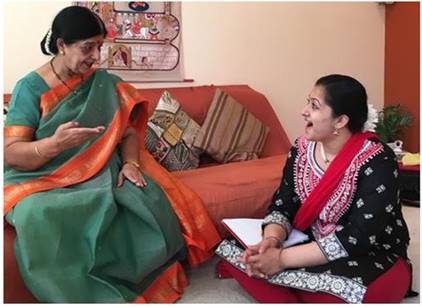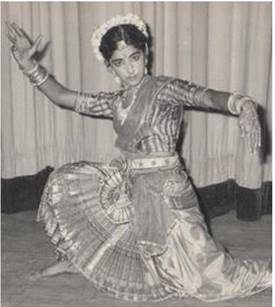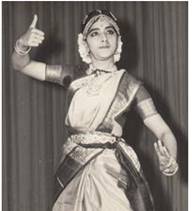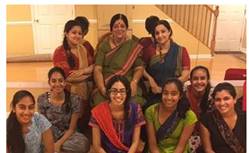By Moha Desai, Bridgeville, PA
Shrimati Tani Desai, mother of Shambhavi Desai of Bridgeville, grew up in a traditional Nagar Brahmin family in Bombay in the 1950s and 1960s. She had the rare experience of earning her degree in Bharatanatyam from MS University in Baroda in the 1960s by staying in a hostel far away from her home, something that was unusual then. Moha, daughter of Shambhavi and Priyadarshi Desai, talked to her grandma on how she got interested in Bharatanatyam that propelled her to go and earn a degree in the dance form in the 1960s. Â
I had a blessed opportunity of sharing the stage and performing a dance piece with my grand-ma (Tani-ma) earlier this summer. She is now in her 60s. It was a magical experience! In the course of talking to her as her granddaughter, I knew that she earned a degree in Bharatanatyam from the MS University in Baroda. This was in the 1960s. With my own exposure to the Indian classical performing arts tradition in the US, I sat with her to hear from her about her times, her journey in working for a degree in dance and much more. Here are some excerpts:

Tani Desai talking to her granddaughter Moha  for this article.
Tani-ma, when you were growing up, what was the society around you, and what was your home environment like?
“I was fortunate to be born and brought up in a large close-knit family in Mumbai with five uncles and aunts. My extended family had an active interest and knowledge about music, dance and dramatics. My father — the eldest in the family — played the flute while other younger uncles and aunts played violin, percussion, Jal Tarang, or were good singers. One of my uncles and brothers were good theatre actors.
“My first guru and uncle, Shri Arjun Desai, trained me in Bharatanatyam and Manipuri dance styles from age five to sixteen. He also introduced me to Guru Devendra Sinha, who taught me Manipuri as well. So, looking back, music and dance had virtually been our way of life while growing up. I was not even conscious about it. It is like a fish not knowing that it is immersed in water.â€
What were the priorities for girls then in general and how did you fit in to those priorities?
“Life during the 1950s and 1960s was definitely not the same for girls as it is these days. Although performing arts were a way of life for me, having a good education was the first priority. I had my schooling in Saint Teresa’s Convent, where discipline and good academics were stressed. I did not get to perform Bharatanatyam or Manipuri at my school like how you all do, but had to do a ‘book-balancing dance’ taught by one of our enthusiastic teachers at school!

 Tani Desai in her student days.
“Like any other girl, I used to help out with the house-hold chores which included ironing our own clothes, talking care of younger siblings and cousins and so on. All this was in addition to a full-day of school, homework, and dance classes/practices every single day in the evenings; and we used to walk two miles to and from our school! As a senior dance student, I was a part of more than 17 dance ballets in a lead role and other solo performances. I had to manage my time very wisely.
“After I completed my high school, I was really at a crossroads. I loved math and wanted to major in commerce for my Bachelors’ degree at a college in Mumbai while continuing my dance in my free time. Luckily, my parents and uncles recognized my passion for dance, and persuaded me to go to M.S. University, Vadodara and major in Bharatanatyam at the Department of Performing Arts. This was the only University at that time in India that offered degrees and post graduate level courses in dance. I finally went to Vadodara, stayed in a hostel for four years and pursued dance. My parents had done the right thing for me. I had found my home away from home! I eventually did my Masters’ degree here — after I had your mom and your mashi!! It was very unusual at that time!â€
What was the attitude of your fellow neighbors and acquaintances?
“The attitude of the people was mixed. Many of our acquaintances were happy for me when I chose to go to Baroda for majoring in dance- but many others raised their eyebrows at the fact that a young girl from a Nagar Brahmin family was 1) leaving the city, 2) staying in a hostel, and 3) then pursuing dance as against other more conventional areas of studies. This did not dampen my spirits but instead helped me to stay focused and determined.â€

In her prime during a recital.
“Your nanu was fully aware of my passion for dance right from Day-1. He has always been supportive of my interest at every stage of my pursuit.  Without his support and understanding, I could not not have done anything in pursuing dance.  However, it took quite a while for me to persuade my father-in-law to pursue my interest in dancing. I am very happy to tell you, eventually, he was the one who accompanied me for my masters admission.  Mind you, this was after my two daughters started going to school. My mother-in-law was always happy with my interests.  I was very fortunate. “
“The curriculum for the Bachelors’ of Performing Arts (BPA) — formally known as Bachelors in Music (B.Mus.) — is an exhaustive four-year degree course that is divided into theory and practical in each year. It includes all important aspects of Natyashastra, Abhinaya Darpana, Bharatarnava, covering the basics of music, dramatics, and the study of all other classical dance styles, folk dances of India, as well as western/modern dance theories and dances of Southeast Asia. The practical included from the basic adavus to full Margams with training in the Tala system and Nattuvangam. The syllabus also had other subjects like Cultural History, Aesthetics, English, Psychology, Physics and Economics.â€
At the university, in the Bharatanatyam coursework, and in the practical classes, what was the language they used for teaching?Â
“The official language of teaching was English; but teaching was usually done using a blend of English, Gujarati and Hindi as we had students from all over India and abroad too. Our teachers went to great lengths to explain the Tamil and Telugu terms and translated them as required.â€
What changes did you see in dance over the years?
“ Well, there are many changes — most of them good. My Guru, Smt. Anjali Mehr in Baroda, introduced us to choreographing Padams in other regional languages, in addition to the traditional Tamil and Telugu. Many experimental works had already started in our times, but now they are being accepted with a more open mind than before.
“As long as the basic technique and the signatures of the art form are not compromised, such changes are healthy. What pains me though at times is the rampant commercialization at the cost of creativity. On the brighter side, learning Bharatanatyam or any other classical dance form has become

Desai with her students flanked by her grand-daughter (left) and Shambhavi her daughter, (right).
fairly common in all parts of India and abroad, and by people from every kind of socioeconomic background. That says it all!â€
What keeps you going, Tani-Ma?
“A lot of things! Gratitude, satisfaction and passion. Gratitude towards God, my parents, my husband and my family — that I could pursue dance all my life in spite of many challenges along the way. It gives me immense satisfaction and pleasure that I could pass on the same passion to my three daughters and the third generation as well.
“It is satisfying that I could inspire hundreds of students through my dance institute, Pagrav, over five decades, and hope to do so as long as I can! Dance, like any other art form is a Sadhana (pursuit with a total commitment) to connect directly with God. One has to follow the Three Ds to excel: devotion, dedication and discipline. There are no other shortcuts.†    ♣
